Keep Reading
What Work-Life Balance Really Looks Like as a Mom and CEO
What does work-life balance really look like when you’re building a business with little ones underfoot? In this honest and behind-the-scenes episode, I’m sharing 10 strategies that have helped me navigate motherhood and entrepreneurship without full-time childcare—from finding pockets of deep work to rethinking routines, home life, and asking for help. If you’re juggling big […]

Paragraph
What does work-life balance really look like when you’re building a business with little ones underfoot? In this honest and behind-the-scenes episode, I’m sharing 10 strategies that have helped me navigate motherhood and entrepreneurship without full-time childcare—from finding pockets of deep work to rethinking routines, home life, and asking for help. If you’re juggling big dreams and snack-time interruptions, this one’s for you.
APPLE PODCASTS | SPOTIFY
Press play for the full interview or keep reading below!
- [00:00]: Introduction to Work-Life Harmony
- [03:08]: Shanna’s Business Journey
- [15:14]: Strategies for Balancing Work and Motherhood
- [25:26]: Streamlining Mundane Tasks
- [30:59]: Understanding Your Financial Needs
- [33:21]: Establishing Routines for Productivity
- [39:47]: Leveraging Technology for Task Management
- [40:16]: The Importance of Daily Outdoor Time
- [41:08]: Strategizing Your Business Offers
- [44:03]: Defining Personal Harmony and Balance
12 Years in Business (And Many Different Seasons)
Before we dive in, I want to give you a brief look at my business journey to set the stage for how things have changed over the past 12 years. This is officially my 12th year in business, and the strategies I’m going to share today have evolved through different seasons of life and work—sometimes out of necessity, other times because my personal desires shifted. I want to show you how I arrived at these 10 strategies, specifically in this current season.
Don’t worry, this will be a brief history—I won’t spend 15 minutes detailing the growth of my business over the last decade—but I do think it’s helpful context. We often don’t see what life looks like behind the highlight reels or the homepage of a website.
It’s so easy to compare our revenue to someone else’s, or our offers to theirs. We look at how frequently others are showing up online—maybe they have a podcast or a YouTube channel—and we wonder, “How are they doing all of that?” But we rarely see the backend of someone else’s life or business. Do they have a team? Kids at home? Full-time childcare? A spouse who doesn’t work?
All of these variables matter, and they’re different for everyone. That’s why I want to share a bit about what my business looks like today, how it’s evolved over the past 12 years, and where I’ve made progress—or not—through the various seasons of running it.
Starting my business in 2013
I officially launched my business in the fall of 2013. At the time, it was fully service-based—I was working one-on-one with clients, mostly in financial planning and management accounting. It was my third year of marriage, so just Kyle and me. Kyle was back in school then, so I was our primary earner.
I had a lot of time to work that first year, and what I learned about work-life balance really came down to boundaries. Back then, I worked a lot simply because I could. I was figuring everything out: my packages, my pricing, what I was offering. It was that “throw spaghetti at the wall” season—try everything, say yes to everything.
In some ways, I’m really glad I did that. Saying yes helped me quickly figure out what I was good at, what I enjoyed, and what I wanted to be known for. It also taught me the importance of setting boundaries and managing my time.
Tracking my time as a service provider
That’s when I started using Toggl to track my time. I still use it to this day and I’m obsessed with it. I even teach all my Blueprint Model students how to use it.
What I love about Toggl is that it helped me estimate how long projects would take. Since I was service-based, I would offer a set of deliverables for a flat fee—but I constantly underestimated how much time it would actually take me to complete everything.
Tracking my time with Toggl quite literally saved my pricing. I always joke that it saved my marriage and my business. I could go on about this, but in that first year, the key to work-life balance was learning to set boundaries.
Over the next three years, my business continued to grow. By 2016, I had reached a point where I simply couldn’t take on any more work myself. At the time, I was running everything on my own. Kyle, my husband, helped with some of the tech, but this was still before we launched any courses—everything was service-based. I handled all the emails, client communications, scheduling—everything. I was completely maxed out.
Pivoting to online courses (and launching The Blueprint Model)
At that point, I hadn’t considered hiring or building an agency model, but I did want to find a way to serve more people. So, Kyle and I sat down at our kitchen table and recorded the very first version of The Blueprint Model, my financial planning course for small business owners.
We basically took what I had been doing one-on-one with clients and turned it into a recorded course so I could teach it at scale. We had 54 students enroll that first round in 2016, which was amazing. I was just starting to dip my toes into the course world.
What I didn’t realize at the time was that this would completely change my business model—and honestly, it changed my life. Financially, personally, professionally—it was transformational. From that point on, my business slowly began to shift toward courses. I eventually hired five full-time employees, continued selling courses, and by around 2018 or 2019, I was no longer doing CFO work or one-on-one client services. I had become an educator and a marketer, and at the time, that felt right.
Taking a sabbatical
Looking back now, I can see clearly that this was a major turning point. In 2019, my husband and I moved states, and he began working full time. I sensed that I needed a shift in my business too, though I wasn’t sure what that would look like. What I did know was that I needed a break. So I took a full-year sabbatical in 2020. I let go of my team, paused all courses, and gave myself a clean slate.
That was my “what would you do if you could do anything?” kind of year. And during that time, I got pregnant with our first daughter. In early 2021, we moved back to Tennessee to be closer to family, and my husband joined the business full-time. Once again, I became the primary earner.
Over the past four years, I’ve run the business with some contract help. Kyle handled the tech side, our podcast, and all the video editing. We’ve worked with contractors for things like email support, podcast editing, and client correspondence—but no full-time employees, and for most of that time, we had little to no childcare.
For the first two and a half years of our oldest daughter’s life, we didn’t have consistent childcare until she started preschool. I was working around 20 hours a week, and Kyle and I tag-teamed childcare. When we had our second baby last year, Kyle returned to full-time work, and I’ve been working around 10 hours a week since.
Learning work-life balance as a mom
That shift is actually one of the main reasons I wanted to record this podcast—I’ve learned so much in the last four years.
I remember when I first launched The Blueprint Model, a lot of moms going through the course would say things like, “Shanna, we’d love to hear your perspective one day when you have kids.” And they were right—motherhood has changed everything.
Even if you’re not a parent, we all have time constraints. For me, motherhood completely changed how I think about my time, my business, and my life. One thing I didn’t mention earlier is that during my sabbatical in 2020, something really profound happened: for the first time, I stopped finding my identity in my business.
When I came back in 2021, I was excited—but I returned with a fresh mindset. This is my job, and I really like my job. But I’ve learned that it’s okay to see it as just that: a job I enjoy, not who I am. It’s no longer my identity. And now, sitting here four years into motherhood, I realize that in many ways, motherhood had become my identity. Not that it’s a bad thing—but I’m in the process now of rediscovering all the different pieces and facets of who I am.
Moving out of maintenance mode
For the first time in four years, it feels like my brain has the space to fully focus on business again. You know what I mean—when your camera roll is no longer screenshots of home decor inspiration but just filled with photos of your kids? That’s been me. But now, I’m starting to think, dream, and plan again—for the business.
And the truth is, my business has largely been in maintenance mode these past four years. It’s gotten very little of my time. As anyone who’s been there can probably attest, running a business at the level mine operates, in just 10 to 20 hours a week, is almost impossible.
It’s been hard, honestly. I’ve often felt that I’m limiting my business’s growth simply because I haven’t had the hours to give. But 2025 has brought about some big realizations and strategic changes—ones I’m genuinely excited about.
That’s what I want to share with you today. Because I finally feel like I can say, “Here’s how you can run a business in limited hours and still operate at a high level.” I’ve realized what works for me. I’ve continued to run a multi–six-figure business, I now have a full-time employee, and I’m still only working 10 to 12 hours a week.
Would I recommend it? Not exactly. It’s not easy. I could absolutely get more done with more time. But this is the season I’m in. I’ve learned to give myself a lot of grace—and a lot of gratitude.
I still need to earn money for my family
I’m grateful I get to choose this time with my kids. I also don’t have the luxury of being a stay-at-home mom—I need to earn an income.
So no, I can’t shut down my business. And the good news is: I don’t want to. I love running my business. I’m proud to do it. I’m excited for my daughters to grow up watching me run a business.
But I’ve had to figure out how to do both—how to show up for my family and still keep my business thriving. I know so many of us are juggling that exact same thing.
So, with that backstory, I hope it’s helpful to know where I am right now. My business still supports my family. I’m intentionally working limited hours, because I know how much time I want to spend with my kids. I love what I do, and I want it to keep growing.
I’m in the messy middle. And I know some of you are right here with me.
What I want to share next are 10 strategies that have helped me personally find harmony in this season of life—between work, motherhood, and everything in between.
Some of these are practical. Some are more mindset-related. As always, take what serves you, and leave the rest.
Let’s dive into the 10 strategies.
1. I Need Our Home To Be Decluttered, Clean, and Organized
Strategy Number One—and I hope this doesn’t make you cringe, but it’s truly been empowering for me—is voicing out loud that I need our home to be decluttered, clean, and organized.
Is it always that way? Definitely not. But I’ve realized just how much physical clutter leads to mental clutter—especially since I work from home. I had to acknowledge that in order to feel productive, my environment has to support that.
For example, I recently heard a quote on Kendra Adachi’s podcast, originally from The Nester:
“If it’s out, it’s decoration.”
I loved that, and I’ve been slowly implementing it in our home. Just being able to say, “Hey, my space affects my focus,” has been a game-changer—especially with how limited my work time is. When I sit down to work, I need to be laser-focused, and that starts with my surroundings.
Putting systems in place around the home
So I’ve put a few systems in place to help. First, we have a house cleaner who comes every other week. That’s been huge. Just knowing the deep-cleaning tasks—floors, bathrooms, dusting—are taken care of helps lighten my mental load. Even if things are cluttered, I know the house is clean underneath.
I’ve also started scheduling time for the rest of the home-related tasks. I think this is probably an idea from Atomic Habits—I haven’t read the book yet, but I watched James Clear’s MasterClass, and it was amazing. The core idea is to make things habitual, so you’re not constantly thinking about them.
So I did just that—I started assigning days to tasks. I literally put on my calendar the nights I bathe the kids. Literally, I scheduled “bedsheet washing” for Sundays. I have a set day for meal planning, a set day for grocery shopping. And it’s helped so much. Instead of waking up wondering if we’ll have groceries or clean sheets, I already know what’s happening and when. Kyle even picks up the groceries on his way home now. These simple rhythms and routines have been so helpful.
Some other practical things we do:
-
We run the dishwasher every single night.
-
We unload it first thing in the morning—before breakfast.
Why? Because when the dishwasher is full of clean dishes, the sink fills up with dirty ones. But if it’s empty, everything gets put straight in. It takes five minutes in the morning, and it makes the rest of the day so much smoother.
I also clean as I cook—it’s just something I’ve always done. I clean out pots and pans as I go, and it makes a huge difference in keeping the kitchen manageable.
Now, I know that home cleanliness can be a really sensitive topic for a lot of women—it can bring up feelings of shame or inadequacy. That’s absolutely not my intention here. I just know that for me, a messy, cluttered house makes it incredibly hard to focus. If I sit down to work and there’s stuff everywhere, I want to get up and clean instead of working.
So I had to put some strategies in place. They’re simple. They’re imperfect. But they help. Even something like having a bin in the living room to toss all the kids’ toys into at the end of the day—yes, it drives me a little crazy—but it’s better than toys all over the floor.
So, Strategy Number One is keeping the house as decluttered, clean, and picked up as possible. Creating simple systems that make our home feel more peaceful has made a huge difference in my ability to focus—especially since I work from home.
2. Establish Clear Work Time & Home Time
I had to get very clear on this one. I’m not someone who blends or integrates work and life well—I need distinct boundaries. I learned early on that the “nap time hustle” just does not work for me.
If the baby didn’t nap or naps were cut short, I’d get anxious and frustrated. I found myself resenting the fact that I couldn’t work, and ultimately, I was mad at my kids for something that wasn’t their fault. That wasn’t okay for me—or for them.
So I made the decision: I’d rather have a full day of childcare and get solid, focused work done than try to squeeze it in here and there throughout the day.
I sat down and mapped out all my tasks and how much time I realistically needed each week. For me, 20 hours is the sweet spot—it’s the amount of time I need to truly make progress in my business.
I can’t rely on nap time
From there, I looked at our childcare availability and carved out when I could work and when I’d be fully present at home with the girls. Again, I knew I didn’t want to rely on nap time. If I did get an hour during naps, great—bonus time. But I wasn’t going to count on it.
I went through a season where I stayed up really late to work—starting when the kids went to bed and clocking 5 hours a night, 4 days a week. That gave me 20 hours, but it was brutal. I got an Oura ring and saw how badly it was impacting my health.
So I pivoted: I started waking up early and working from 5 a.m. to 8 a.m., five days a week. It was hard, but I’d rather wake up early than stay up late—and it worked much better. Then I added one full day of childcare to round out the week. That rhythm has been our sweet spot.
Right now, as I record this, we’re heading into summer and I’m so excited because we have a nanny who will be with us two full days each week—12 hours of dedicated childcare. I can’t wait to see what I can get done in 20 actual focused hours.
Our Four Quadrant Time Chart
When your work time is extremely limited, you have to get ruthless about where your time goes. That’s something I teach in The Blueprint Model. We use a tool called the Four Quadrant Time Chart (definitely needs a better name!). It’s probably similar to the Eisenhower Matrix, but it’s so helpful.
Here’s how it works:
First, brain dump everything—personal tasks, business tasks, everything you do in a week or month. Then, sort them into four categories:
-
Gold – Income-Producing + Dreamy
These are tasks you love doing and that make money. Prioritize these. Protect your time for them. -
Inspirational – Dreamy but Not Income-Producing
These are things you enjoy but could be outsourced or aren’t essential. Think: updating your website or designing in Canva. They’re fun and sometimes creatively energizing. I recommend scheduling these in occasionally—maybe once a week or month—so you still get to do what fills your cup. -
Mundane – Income-Producing but Not Dreamy
These are the things that bring in money but you don’t necessarily enjoy—like checking email, invoicing, or doing groceries. These are great candidates for outsourcing or automating. -
Clutter – Not Dreamy + Not Income-Producing
These are the tasks that drain your energy and don’t move the needle. For me, this is why I quit Instagram in 2017. I realized it wasn’t bringing enough ROI compared to other strategies like SEO, long-form content, and Pinterest.
I redo this exercise regularly because I have so little time to spare—and it helps me stay focused on what really matters.
3. Ask for Help/Hire Help
This ties directly into those mundane tasks. If something has to be done but it’s not the best use of your time, get creative.
Personally and professionally, I’ve outsourced where I can. We have a house cleaner every other week. We’ve done meal delivery. We regularly use grocery delivery or pickup.
In business, I’ve hired podcast editors, virtual assistants, blog and Pinterest help, and contractors for email support and graphics. There’s so much more I’d love to delegate too—it’s all about getting creative and starting somewhere.
Now, I know the immediate thought for many is: “I can’t afford to hire help.” And I get that—it can feel like a big hurdle. But here’s how I started thinking about it:
Let’s say it takes me an hour to go grocery shopping. I could pay the $12.99 Instacart delivery fee and use that hour to work instead. If I take a $375 client call during that hour, the math makes total sense.
Even if you’re not replacing that exact time with a billable task, thinking this way helps you prioritize revenue-generating work. For example, if I pay $100 for a few hours of childcare, I ask myself:
“What do I need to get done during that time to justify the investment?”
Maybe it’s writing a newsletter, creating a product, or pitching new clients.
When you start thinking this way—about the value of your time—it becomes so much easier to justify hiring help. The goal isn’t to spend money frivolously—it’s to protect your limited hours and focus on the work that moves the needle.
Hire Someone Who Can Actually Do Your Job
One thing I really wish I had done earlier: hiring someone who could actually do my job—not just help with tasks around the edges, but truly take on the core work I’ve always done myself.
Over the years, I’ve hired lots of people—contractors, employees—for all kinds of support roles. But until 2025, I had never hired someone who could step in and do the work I do.
I never even considered the agency model. I didn’t think I wanted to manage people like that and I didn’t think I liked being a “boss.” But I’m telling you—it’s been life-changing.
Hiring an accounting professional, training them to handle our CFO and bookkeeping clients, and letting them take over things like spreadsheets, financial reports, and presentations—these were all tasks I thought only I could do. And now, someone else is doing them really well.
It has taken so much off my plate. And it’s given me something I didn’t realize I needed: margin.
So whatever this looks like in your business, I want to encourage you—don’t just outsource the stuff you dislike or the things that aren’t a good use of your time. Consider hiring someone who can actually multiply your impact. Someone who can do the work you do.
For me, that’s what’s been truly transformational.
4. Know Your Enough Number
I say this a lot—and I know it might sound overly simple—but one of the best things you can do for your business is to know your enough number.
This is the number that covers your personal expenses, your business expenses, your team… everything. We call it your “enough number,” your financial freedom number, your sales goal. Whatever you call it, it’s a number that brings peace of mind. It’s the foundation for your strategy.
For example, let’s say my enough number is $100,000. That’s the minimum I need to bring in annually. It doesn’t matter how I reach it—whether that’s 10 clients at $10,000 or 1,000 sales at $100. That number gives me clarity. I know exactly what I’m working toward.
And listen—we’re entrepreneurs. We’re scrappy. If you know your number, I truly believe you can hit it. Even if you’re doing what I used to call “non-portfolio work”—the stuff you don’t love, wouldn’t showcase, and don’t want to repeat—it’s okay if it pays the bills.
There’s power in knowing what “enough” looks like for you. If you’re sitting there thinking, “Shanna, I don’t even know where to start,”—how to create a budget, how to figure out my enough number—I’ve got a free class that walks you through it.
It’s a 30-minute class, and it’s simple, super practical, and actually fun. If you don’t know your number yet, start there.
5. Create a Wind-Down Routine
I’m sure you’ve heard of morning routines—but a wind-down routine has been just as essential for me. At the end of each work session—whether it’s my early morning block or a full day with childcare—I take a few minutes to close out intentionally.
Here’s what that looks like:
-
I review my to-do list.
-
I check what I actually got done.
-
I make note of what’s still outstanding.
-
Most importantly, I prioritize the top three tasks for my next work session.
That way, the next time I sit down, I’m not wasting precious minutes figuring out where to start. I already know what matters most.
6. Maximize Your “Tiger Time”
Some people call it “ramp-up time,” others call it “deep work.” I have a friend who calls it “tiger time.” Whatever you want to name it, this is your focused, no-distractions work block—and for me, that’s the early morning.
During this time:
-
I turn off all notifications.
-
I don’t check email.
-
I don’t do busywork or admin.
Instead, I pull out the three priorities from my wind-down list, and I start there—with the most important, high-impact tasks. For me, that’s things like:
-
Writing content
-
Recording podcasts
-
Writing newsletters
-
Anything that requires deep thought and creativity
That’s why I love doing it first thing in the morning—it’s the quietest part of the day in our house. And I’ve learned that I’m very easily distracted. So I use that quiet time for the hardest things that require my full attention.
Because we’ve all had that feeling, right? You’ve got something important lingering in the back of your mind, but then life happens—traffic, errands, interruptions—and suddenly your one-hour block turns into 20 minutes. You feel scattered and frustrated.
That’s why I guard my tiger time. I tackle the most critical things first—the things only I can do—so even if the rest of the day gets chaotic, the most important work still gets done.
7. Use a Task Management Software (I Love Asana!)
Okay—this one might sound dramatic, but I genuinely don’t know how I’d run my life or business without Asana. I’ve been using it for close to 10 years—maybe longer—and it just works for my brain.
Now, I get it: not everyone loves Asana. Some prefer Trello, ClickUp, Notion—there are tons of great options. But the key is this: find the system that works for you.
Why I love Asana so much is simple—it gets everything out of my head. I’m not walking around with a mental to-do list running on a loop. And if you know that feeling (please email me or leave a comment and tell me I’m not alone!), you know how overwhelming it is to carry everything in your brain.
With Asana, I’ve replaced all those sticky notes, planners, and random scraps of paper taped to my computer. Everything lives in one place:
-
I can assign tasks to myself or my team.
-
I can add deadlines.
-
I can organize tasks into specific projects.
-
I even have a personal board for life stuff—like paying bills, grocery shopping, meal planning, or house projects.
I also have an ideas board—just a catch-all space for business thoughts like:
“Update the website,”
“Add a bonus to the Blueprint Model,”
“Create a new freebie,” etc.
Even if I don’t plan to act on it now, it goes in Asana. That way, nothing gets lost—and nothing clutters my brain.
Our team lives in Asana too:
-
Our editorial calendar is in there.
-
Podcast schedules, deadlines for blog posts and graphics—it’s all in one shared space.
So whether it’s Asana or something else, the strategy here is: find a tool that gets the to-do list out of your brain and into a trusted system. It’s been life-changing for me.
8. Get Outside Every Day
This one is simple but powerful: I have to get outside every day, rain or shine.
Usually, it’s around 4 p.m.—that pre-dinner hour when everyone’s getting a little stir-crazy. A lot of the moms in our neighborhood head out then too, so we often end up going on walks or just hanging outside while the kids play.
It’s such a helpful mental reset at the end of the day.
My husband usually gets home around 5 p.m. and takes over with the kids while I cook dinner—which I actually really enjoy. That little window of “Shanna time” while I cook is sacred to me, and being outside beforehand helps me transition into that slower rhythm.
Even when it’s raining, we’ll sit on the front porch and just watch the rain. We’re lucky to have a wide, farmhouse-style porch that runs across the front of our house, and I love that space.
There’s just something grounding and restorative about fresh air. It helps me reset mentally and be more present with my family.
9. Get Strategic About Your Offers
This could easily be its own podcast episode—I’ve learned so much about this over the years. When I started my business, I was 100% service-based. A few years in, I transitioned to digital products and eventually focused almost entirely on The Blueprint Model, my signature course. It stuck around the longest, and I’ve dabbled in other things like workshops here and there—but the course was my foundation.
For a long time, that worked. I love the course model—it allows you to serve more people at scale, and I definitely don’t see education leaving my offer ladder anytime soon. But here’s what I realized in recent years:
To succeed in the digital space, you have to be a full-time marketer.
Your business constantly needs to bring in new people. And in the season of life I’m in, that level of marketing energy just started to feel exhausting. What I really craved was recurring, reliable, predictable income—something I could count on every month.
I used to work in finance, and one of the things we’d talk about was residual income—building a portfolio that pays you over time. Eventually, your residuals become your “salary.” That concept really stuck with me. And I realized: I didn’t have an offer like that in my own business.
That’s why some people build memberships or retainers. And let me be clear: this isn’t just about money. Yes, we want financially sustainable businesses—but we also want to serve our clients well in ways that work with our lives.
So ask yourself:
-
What does your life look like right now?
-
How much time do you realistically have to give?
-
How much do you need to earn?
If your goal is $100,000 and you only have 10 hours a week, which is more sustainable—booking 10 $10K clients, or selling 1,000 $100 products?
Digital products may seem easier—but they require constant marketing. So it’s not passive income. That’s a myth. The key is to get clear and strategic about what you’re offering, and whether it aligns with your current season of life.
Sometimes, you just need to ask:
“How can I serve my audience in a way that also serves my family?”
That’s been the big mindset shift for me.
10. Define What Harmony of Work-Life Balance Means To You
This one is more mental than tactical—but it’s everything.
Ask yourself:
“What does work-life harmony really mean to me?”
Be ruthlessly honest.
-
How many hours are you actually working?
-
How much do you want to earn?
-
What do you want your days to look like?
-
What time are you waking up and going to bed?
-
Are you reading in the morning? At night?
-
What kind of rhythm makes you feel aligned?
For me, restlessness shows up when I’m in comparison mode—comparing my business, my parenting, my marriage, my home, my everything to someone else’s.
The truth? I don’t want to show up on Instagram every day. I don’t put makeup on daily. Right now, I’m more focused on summer activities with my kids than planning a launch. That’s okay.
But I had to ask myself:
“What does being a good mom look like for me?”
I’ve got amazing mom friends who do beautiful things—raising butterflies, creating educational play—things I deeply admire. But I’m not always doing those things. And if I’m not careful, I can start thinking,
“Am I a bad mom because I’m not doing that too?”
So I had to define it. I needed a clear, personal definition of what “being a good mom” means for me. Because I’m a competitor by nature—I want to do things well. But that gets exhausting if the finish line is constantly moving… or if I’m not even sure what the finish line is.
So I’ll leave you with this:
Get clear.
Get specific.
Define what harmony means for you.
And if you’re a working mom, ask yourself what being a good working mom looks like—for you.
📌 RESOURCES MENTIONED:
- Toggl
- Oura
- Asana Task Management Software
- Atomic Habits
- Kendra Adachi episode
- James Clear Masterclass
- Finance Friday Newsletter
- Free Budgeting Class
More from this Episode
To hear more, press play on the player above for the full interview or click here to download the transcript.
May 8, 2025
Previous Post:
Next Post:


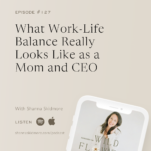


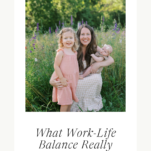
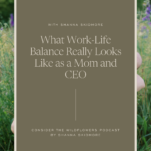
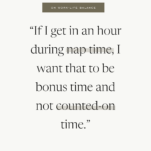
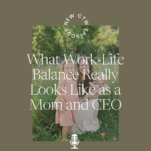
And if you found this helpful, share with your friends!